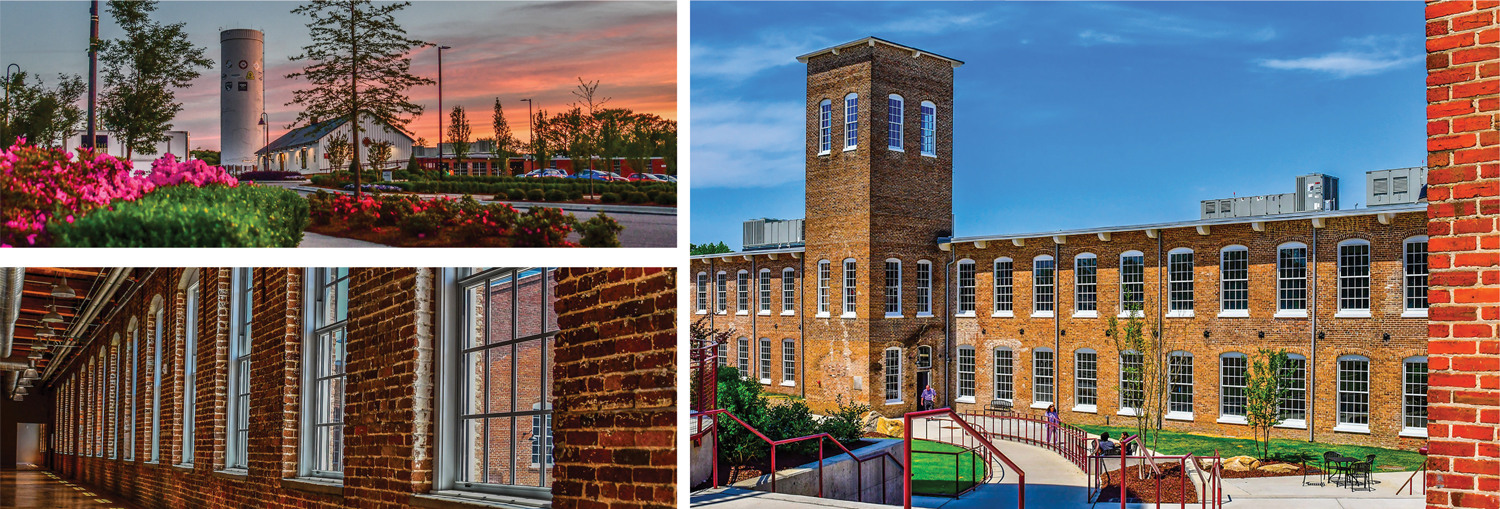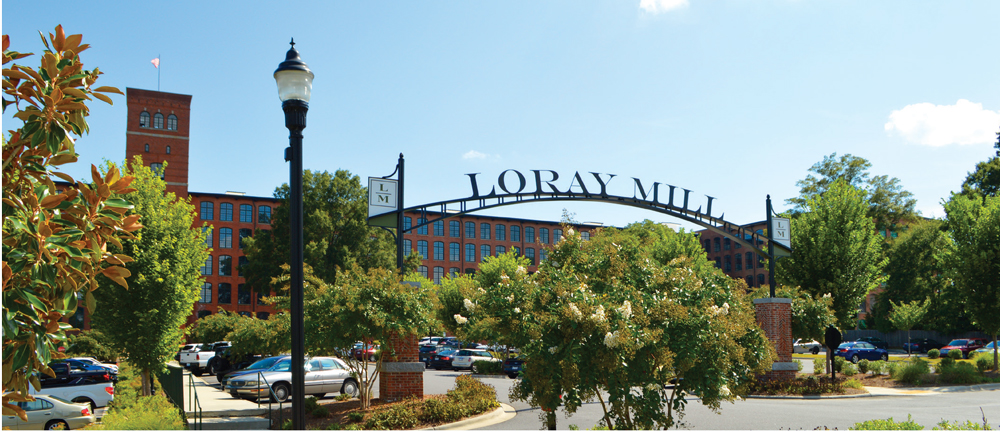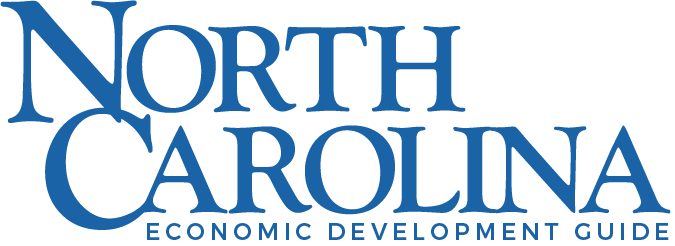PAST AS PROLOGUE
Many of North Carolina’s historic mills, which once produced tobacco, textile, furniture and other goods, are being reborn thanks to tax credits. Residents, startups and established companies are embracing the renovations, where work, residential and recreational opportunities are woven together.
—By Lawrence Bivins
It has been nearly five years since Kristi Ellis and her husband, Travis, relocated to Rocky Mount and opened Goat Island Bottle Shop. Craft beers, including gluten-free and non-alcoholic options, specialty wines and packaged foods fill its shelves. It hosts public events year-round, including an Oktoberfest every fall.
The couple’s success led them to acquire Tipsy Tomato, a wood-fired pizza parlor only a few steps from their bottle shop at Rocky Mount Mills, about two years ago. “We get a good base of locals at both businesses,” says Florida-native Kristi. Their customers include people who live, work or both at the mixed-use development, which isn’t far from the intersection of Interstate 95 and U.S. 64. “We do see a lot of people from out of town, too,” she says.
Rocky Mount Mills has seen plenty during its more than 200-year history. Historians believe it’s North Carolina’s second-oldest and longest-active cotton mill, working until 1996. Its time processing cotton was punctuated by two devastating fires, one set by Union soldiers during the Civil War. While it was rebuilt after each blaze, the work was nowhere near the scope undertaken by its current owners.
Raleigh-based Capitol Broadcasting Co. purchased Rocky Mount Mills in 2007 and turned it into 82 acres of residential, educational, commercial and cultural space with the help of tax credits. It wasn’t the first time the owner of television station WRAL had done this. It engineered a similar transformation at American Tobacco Campus in Durham — where it also owns the Durham Bulls, a Triple A baseball team — almost two decades ago.
In addition to 67 loft apartments and 55 single-family “village” homes, Rocky Mount Mills offers views of the Falls of the Tar River and 120,000 square feet of office space. Corporate tenants include a law firm, optical shop, Teach for America’s regional headquarters and offices of the Rocky Mount Telegram, the local daily newspaper. Tipsy Tomato is one of five restaurants on the property, which join seven craft brewers. Nash Community College teaches craft brewing on-site, where it has a business incubator for breweries, too.
Renovation, revitalization and reuse of North Carolina’s historic mills isn’t restricted to its northeastern corner. It’s happening statewide. In Hickory, for example, Hollar Mill, which once produced cotton knit goods, is now home to retail, restaurant and event space. And at the other end of Highland Avenue stands the former Lyerly Full Fashioned Mill, which also dates to the 1930s. The local historic landmark was purchased by global logistics provider Transportation Insight and became its headquarters in 2015 after award-winning renovations.
Turning mills into mixed-use developments that can launch small businesses, meet the needs of existing companies and offer the living amenities that today’s workers seek isn’t a small endeavor. But the payoff is large for all involved.

Rocky Mount Mills photos by Carl Lewis
ECONOMIC INCENTIVES
Credit North Carolina’s vivid but gritty industrial history for sprawling properties such as Rocky Mount Mills. Beginning in the early 1800s, it and others hummed with machines and workers, turning raw materials into a host of products, though none more than textiles, tobacco and furniture. It was one of the South’s most industrialized economies by the 1960s, when manufacturing employed one-third of North Carolina’s workforce. But low-skill jobs dominated, and the per capita income, for example, was just 71% of the U.S. as a whole, according to a 2010 report from N.C. State University’s Institute for Emerging Issues.
North Carolina manufacturing weakened as attitudes about tobacco changed and global trade tariffs were eliminated. Many companies fled offshore, seeking better opportunities, including less expensive labor. In their place grew new industries such as biotechnology, financial services and transportation equipment. But they required custom factories and office space. As the 20th century came to a close, the state was left with empty factories and mills, reminders of former economic glory and targets of vandalism. The situation alarmed preservationists, who were eager to save theses historic structures from demolition.
Legislators responded with an expansion of the state’s tax credits for historic rehabilitation projects in 2006. Its Historic Mill Rehabilitation Tax Credits, which cover industrial buildings — broadly defined to include warehouses and associated offices — grabbed developers’ attention. The program, which was revamped in 2016, according to Preservation North Carolina, starts with a 20% federal tax credit for income-producing historic properties. Add to that a 15% state tax credit for renovations that cost up to $10 million. Economic Development Partnership of North Carolina says expenses between $10 million and $20 million receive a 10% tax credit. A 5% bonus is added on all expenses, up to $20 million, for renovations done in Tier 1 or Tier 2 counties. N.C. Department of Commerce annually ranks the economic health of the state’s 100 counties, from the 40 most distressed — Tier 1 — to the 20 least challenged — Tier 3.
The tax-credit program was a brilliant move by North Carolina lawmakers, says Donovan Rypkema, principal at Washington, D.C.-based PlaceEconomics, which provides research, consulting and training services in support of historic preservation ventures. The program turned what appeared to be a liability — a vast inventory of abandoned properties — into an asset. “It has made a miraculous difference,” he says.
North Carolina State Historic Preservation Office says between 1976, when the federal tax credit was initiated, to the end of 2020, there were more than 1,600 projects on income-producing historic structures representing an investment of almost $2.7 billion. “Many others are in progress right now,” says Myrick Howard, president of Preservation North Carolina, which helped the state develop the tax-credit program. “We pitched it as a pilot project just to see what would happen,” he says. “It went way beyond our expectations.”
Historic properties otherwise poised for the wrecking ball were granted new life as 21st century spaces for living, working, innovating, gathering and recreating. And the direct economic impact has been significant. Howard says rehabbing older buildings is more labor intensive than new construction. “[It] is a huge job producer, because it’s happening on the ground with local labor and local materials,” he says. “It’s not something you can turn into a commodity. That’s great from a jobs standpoint.”

Winston-Salem is reflected in windows of a building at Innovation Quarter. Bailey Park, right, is the center of social life at the mixed-use development. Photos courtesy of Innovation Quarter.
FORMULA FOR SUCCESS
Few communities have more to show from the tax-credit program than Winston-Salem, whose Innovation Quarter has turned former R.J. Reynolds Tobacco Co. buildings into a cutting-edge collection for education, research and development, health care and urban living. Along Vine Street, factories No. 90 and No. 91 are now contemporary commercial buildings, modernized with the help of $350 million in tax credits. “Downtown Winston-Salem is unreal,” Howard says.
Originally called Piedmont Triad Research Park, Innovation Quarter grew out of Wake Forest Health Science’s need for additional research space in the early 2000s. After considering new construction on greenfield sites, leaders looked downtown. They began exploring opportunities for collaboration with Reynolds. The tobacco titan ultimately gifted its 40-acre properties, which aren’t far from where its headquarters still stands. “We started working on that in 2009,” says Graydon Pleasants, head of real-estate development at Innovation Quarter. While the Great Recession did little to further the effort, mill credits did. “We immediately rolled through every tax credit available,” he says. “And we focused on what we could do quickly.”
Innovation Quarter is a busy place. More than 3,600 people work at 90 companies and 1,800 students pursue a degree. Its partners include local governments and Winston-Salem’s five higher education institutions. Among the entities now involved with the venture is the Bowman Gray Center for Medical Education, which was completed in 2016. Renovated and developed by Baltimore-based Wexford Science + Technology, the 168,000-square-foot space includes tiered classrooms, a simulation-based instructional center, computer labs, study areas and dining space. The Bowman Gray Center is one of six Innovation Quarter buildings Wexford has updated.
Atriums, open spaces and an abundance of natural light create a welcoming look and feel while blending old with new. “There’s nothing like walking through these buildings,” Pleasants says. “It’s some pretty inspiring space.” Innovation Quarter has coworking space, fitness centers, loft apartments, coffee houses and office suites designed with startups in mind. Buildings are connected by 20 miles of greenways. The center of the Quarter’s community life is 1.6-acre Bailey Park. “It’s a highly programmed environment,” he says. In addition to standard park amenities, food trucks, live music and outdoor yoga classes are regularly scheduled. “It includes anything we can do to create a portal into the Innovation Quarter.”
Innovation Quarter has proven beneficial to the broader community and its efforts to create next-generation jobs in the one-time mecca of tobacco. Laura Johnson Lee, senior vice president at Greater Winston-Salem Inc., calls the property a “key asset” for the region’s economic development vision. “The impact of the Innovation Quarter is not limited to its property lines,” says Lee, who oversees business recruitment and retention for Forsyth County. “As one of the world’s leading innovation districts and the only development of its kind in North Carolina, it has come to represent a vibrant identity for Winston-Salem as a destination filled with creativity and innovation.”
Innovation Quarter’s success hasn’t gone unnoticed outside of the Triad. Winston-Salem-based Wake Forest Baptist Health announced it was joining Charlotte-based Atrium Health in October 2020. Atrium has plans for a large innovation district in its hometown that will include a new Wake Forest University medical school. Atrium is seeking $75 million from Mecklenburg County and the city, whose leaders toured Innovation Quarter in October 2021, for the project.

Loray Mill photo courtesy of the City of Gastonia
BIGGER DEAL
A 20-minute drive west of Charlotte, Gastonia has a history that’s tied to textiles. It includes Loray Mill, which at one time was the world’s largest mill under one roof. An effort to organize its workers sparked a strike in 1929. Violence soon followed, which resulted in two deaths, including the city’s police chief. “It’s a very interesting history,” says Kristy Crisp, Gastonia’s economic development director.
Built in 1902, six-story Loray Mill had sat empty since it closed in the late 1980s. In 2013, renovations began, converting the 600,000-square-foot mill into a modern mixed-use community. Loray’s 189 loft apartments quickly drew takers, from young Charlotte professionals seeking affordable alternatives to Queen City real estate to empty-nesters hungry for low-maintenance living in a walkable downtown. The pandemic energized demand for the apartments. “There’s a waiting list,” Crisp says. “More people are rethinking office work for less dense environments.” She anticipates Loray’s 80,000 square feet of retail and commercial space will draw comparable interest once it opens.
Reinventing downtown Gastonia began with Loray’s conversion. And it’s continuing with the city’s ambitious Franklin Urban Sports and Entertainment — FUSE — District, which has drawn attention from private developers. A lifelong resident of the community, Crisp is excited by the number of businesses and residents moving into the district. “When Loray was redeveloped, that was the kicker for a lot of what has happened since,” she says.
The FUSE District got a major boost in 2021, when CaroMont Health Park opened. The 5,000-seat multipurpose venue, which is six blocks from Loray Mill, is home to the Gastonia Honey Hunters, the newest Atlantic League of Professional Baseball team. City officials expect to offer family, music and entertainment events year-round at the park, which has indoor and outdoor banquet areas, a covered beer garden and 4,000-square-foot “Premium Club.”
Plenty is in play throughout the FUSE District. Casual and fine dining restaurants, along with a cigar and wine bar, are set to open. A boutique hotel is in the works, and coworking options should be available soon. Class A office space is part of the vision, too. Across the street from the stadium is Trenton Mill Lofts, an 89-unit residential environment cast inside an 1897 textile plant said to be the city’s second mill and oldest still standing. Florida-based Kaufman Lynn Construction is renovating the site, which will offer studio, one- and two-bedroom apartments.
Crisp says FUSE is helping drive the local economy. “What has been rewarding is that private developers were and are interested in being close to it,” she says. Like Innovation Quarter, it includes important educational partners such as Belmont Abbey College and Gaston College, which are helping the community preserve the best of its textile-era past while forging ahead with plans for a diversified, connected local economy that draws residents, companies and investment capital. “Our goal is to get to that next level,” she says. “There’s great stuff happening here.”
Photo credit for featured images: Present day view of Innovation Quarter and Winston-Salem by Ian McIlwraith for Unsplash; Vintage view courtesy of Innovation Quarter

